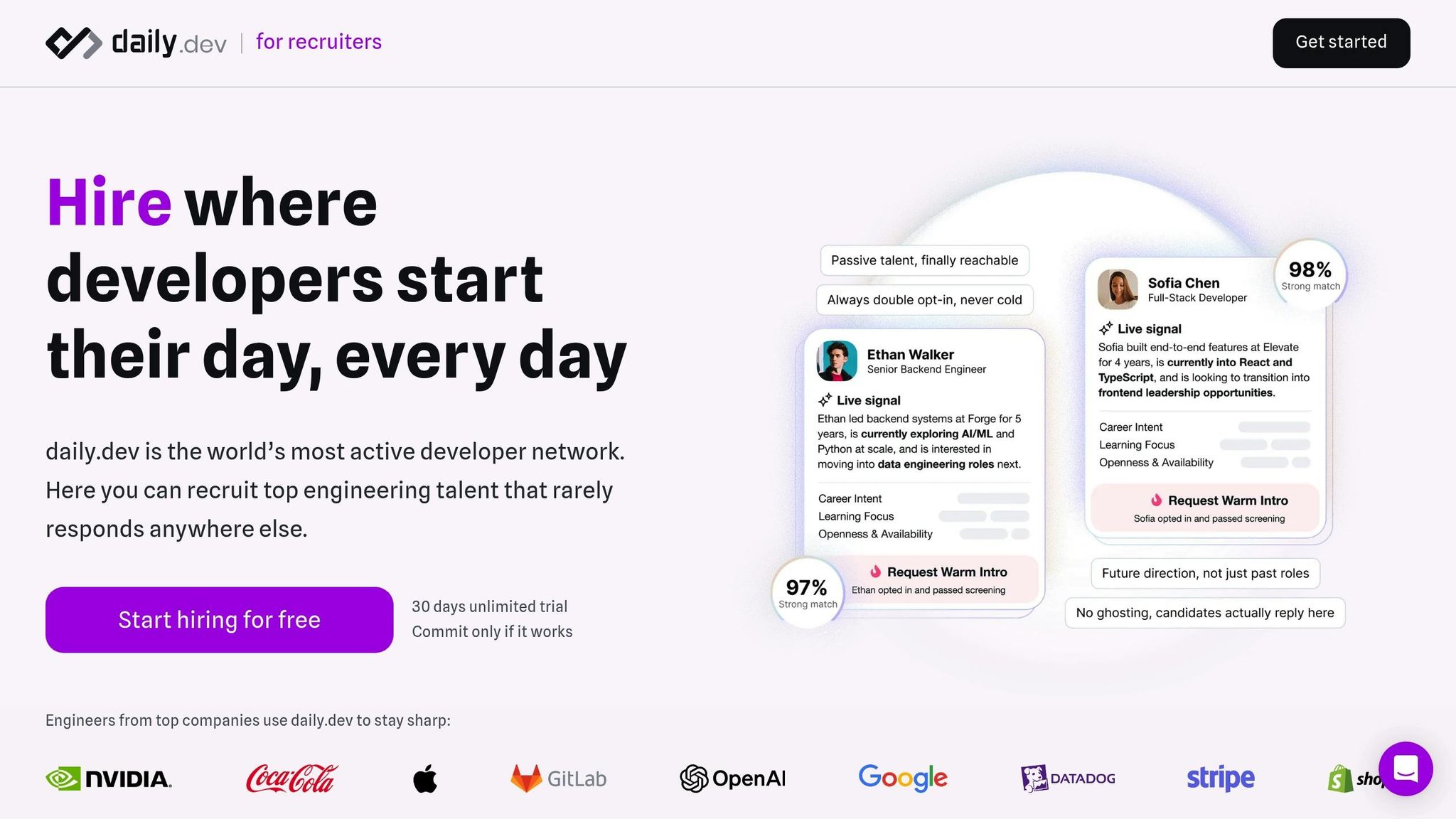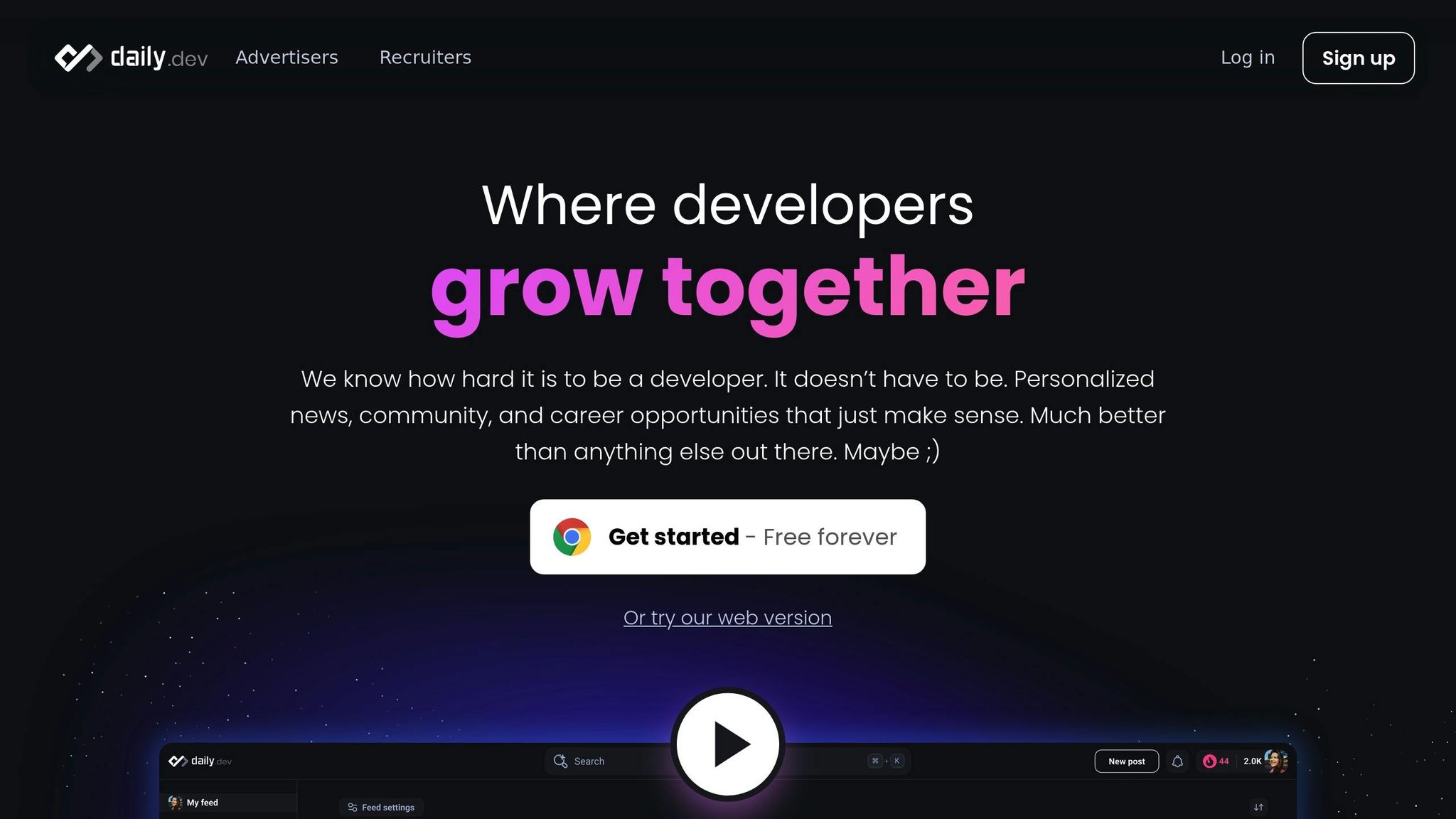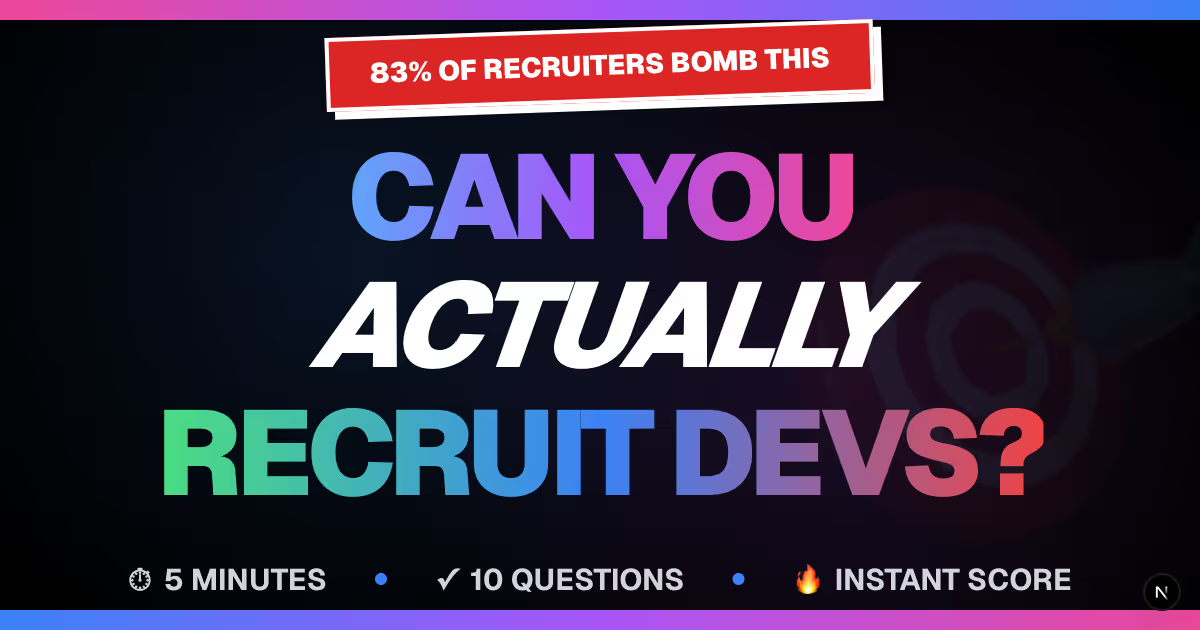


Explore how passive recruiting enhances hiring by connecting with top developers through trust-based relationships and targeted outreach.
Passive recruiting connects with professionals who aren’t actively job hunting but are open to the right opportunities. Instead of relying on cold outreach or job boards, it focuses on building trust and relationships through targeted, double opt-in introductions. This method is especially effective for hiring developers, addressing common frustrations like irrelevant outreach and impersonal processes.
Key Takeaways:
- Higher-Quality Candidates: Engages experienced developers, with 40% being senior-level contributors or leaders.
- Better Response Rates: Double opt-in introductions see 85–90% reply rates compared to single-digit responses from cold outreach.
- Improved Retention: Transparent processes align roles with skills and career goals, reducing turnover.
- Efficient Recruiting: Saves time by pre-qualifying candidates and connecting only with those genuinely interested.
By leveraging trusted networks like daily.dev, passive recruiting not only fills immediate roles but also builds long-term talent pipelines.
Main Benefits of Passive Recruiting
Access to High-Quality Developer Talent
Passive recruiting opens the door to talent that traditional hiring methods often miss. This strategy focuses on a different tier of professionals - 40% of the developers on daily.dev are senior individual contributors and leaders. These are seasoned experts who tend to be selective about their career moves. With 1 billion developer sessions logged, daily.dev has built a thriving community where developers actively engage with technical content and stay up-to-date on industry trends. This pool of skilled talent creates an ideal foundation for building strong, effective teams.
Better Team Fit and Retention
Passive recruiting stands out because it prioritizes aligning roles with a developer's skills and career aspirations. The process goes beyond just resumes, using custom screening questions to ensure candidates meet both technical and cultural criteria set by hiring managers. Developers also receive detailed information about the role upfront, allowing them to make informed choices about whether to proceed. This transparency not only improves the quality of matches but also reduces the likelihood of early turnover, leading to stronger, long-lasting team dynamics.
Passive vs Active Recruiting Comparison
A closer look at the differences between passive and active recruiting highlights why the passive approach often delivers better results:
| Aspect | Passive Recruiting | Active Recruiting |
|---|---|---|
| Candidate Quality | Pre-qualified developers aligned with specific criteria; 40% are senior ICs and leaders | Broad applicant pool, often lacking precise role alignment |
| Response Rates | High reply rates, with early cohorts achieving 85–90% | Lower response rates, especially with unsolicited outreach |
| Team Alignment | Custom screening ensures alignment with hiring goals beyond resumes | Relies heavily on resumes and standard applications |
| Candidate Intent | Developers review roles and opt-in before engaging | Many candidates apply casually, exploring options |
| Long-term Outcomes | Improved retention through transparency and cultural alignment | Higher risk of mismatches and turnover |
| Talent Pool Access | Includes candidates who typically ignore outreach | Limited to actively job-seeking individuals |
"Because they choose to. Every introduction is double opt-in, which means the developer has already reviewed the role and agreed to the conversation. In early cohorts, reply rates consistently exceed 85–90%." - daily.dev Recruiter
This method shifts recruiting from a numbers-driven approach to a more focused and effective strategy. Every interaction is intentional, increasing the likelihood of meaningful connections between developers and hiring teams. Both parties enter discussions genuinely interested in exploring the opportunity, making the process more efficient and rewarding.
The Secret to Recruiting Passive Candidates (Most Companies Miss This)
Building Relationships with Passive Talent
When it comes to passive recruiting, the focus should be on building trust and fostering genuine connections. The key is to engage with passive developers in the spaces they already frequent and trust.
Relationship Building Methods
Connecting with passive developers requires a strategy that goes beyond traditional recruiting tactics. It's about meeting them on their terms and creating meaningful interactions.
Tapping into Developer-First Communities is a crucial starting point. Developers naturally gravitate toward platforms where they can learn, collaborate, and stay informed. These spaces prioritize their needs, making them ideal for authentic engagement. When recruiters present opportunities within these environments, developers are more open to discussing their careers because they feel the interaction is genuine and not just transactional.
Tailored and Thoughtful Outreach makes all the difference. Before reaching out, it's essential to understand a developer's skills, interests, and career aspirations. This means digging deeper than a typical resume and gathering insights that reflect their unique journey. When outreach feels personalized and relevant, developers are far more likely to respond positively.
Being Transparent from the Get-Go is another cornerstone of trust. Sharing detailed information about the role, the company, the technical challenges, and potential growth opportunities upfront shows respect for the developer's time. When developers have all the details from the beginning, they can make informed decisions, leading to more meaningful conversations.
The Double Opt-In Approach ensures every interaction is intentional. By allowing developers to review opportunities and decide whether they want to engage, this method respects their time and preferences. It also ensures recruiters are speaking with candidates who are genuinely interested, making the process more productive for both sides.
These methods not only improve response rates but also enhance the quality of candidates and shorten the hiring process, creating a win-win for everyone involved.
Benefits of Trust-Based Recruitment
Shifting to a trust-based recruitment model changes the dynamic between recruiters and developers, leading to better outcomes on all fronts. As Nimrod Kramer, Head of Product at daily.dev, aptly puts it:
"Trust is the currency of modern recruiting"
This approach moves away from transactional interactions, focusing instead on building lasting relationships.
Increased Response Rates: Developers are far more likely to engage when approached through platforms and methods they trust. It’s a clear indicator that how and where you connect with developers matters as much as what you offer.
Better Candidate Matches: Trust fosters open and honest conversations. Developers are more likely to share their true goals, concerns, and aspirations, enabling recruiters to make stronger matches. This alignment benefits both the candidate and the hiring manager, as it ensures the role fits not just skills but career ambitions.
Stronger Long-Term Connections: A respectful and value-driven first interaction often leaves a lasting impression. Developers remember recruiters who treated them well, which can lead to future placements, referrals, and a positive reputation within the developer community.
Faster Hiring Timelines: When candidates are well-informed and genuinely interested, the recruitment process becomes more efficient. Instead of spending time on basic introductions, both parties can dive into deeper discussions about fit and expectations, speeding up the overall timeline without compromising on quality.
This shift from traditional recruiting to trust-based relationship building redefines how developers are approached. By treating them as professionals and offering transparency, respect, and real value, recruiters can establish the foundation for lasting talent pipelines that benefit everyone involved.
sbb-itb-d1e6221
Tools and Methods for Passive Developer Recruiting
Finding the right tools and strategies can make all the difference in passive recruiting. Unlike traditional recruiting, which often relies on mass outreach, passive recruiting requires approaches tailored to how developers work and interact within their professional circles.
Developer-Focused Platforms for Recruitment
Specialized platforms have become essential for passive recruiting, especially when building trust-based connections. These platforms are designed to meet developers where they naturally spend their time - whether that's learning new skills, staying updated on technology trends, or engaging with their professional community. The goal is to integrate recruitment seamlessly into developers' routines, offering authentic and personalized interactions rather than generic outreach. Developers value their time, so recruiters must approach them with relevance and respect.
One of the standout benefits of these platforms is their ability to provide contextual engagement. Instead of bombarding developers with unsolicited messages, these tools introduce opportunities when developers are already focused on advancing their careers or skills. Many platforms also offer detailed candidate profiles, allowing recruiters to target the right prospects with precision and relevance.
daily.dev Recruiter Features

daily.dev Recruiter is a platform specifically designed for software engineers, connecting employers with passive, pre-qualified candidates in a way that feels natural and non-intrusive. Here's how it works:
- Warm, double opt-in introductions: Developers only engage after reviewing the opportunity, ensuring recruiters connect with candidates genuinely interested in having a conversation.
- Developer-friendly job briefs: Standard job postings are transformed into content that resonates with developers, emphasizing technical challenges, growth potential, and company culture. These briefs are shown only to developers whose skills and interests align with the role.
- Custom screening integration: Recruiters can pre-screen candidates through tailored questions, ensuring that only those who meet the hiring manager's criteria are introduced.
- Seamless ATS integration: The platform integrates directly with applicant tracking systems, simplifying workflows by deduplicating candidates and transferring introduction details smoothly.
- Access to hidden talent: Recruiters can connect with developers who aren’t actively job hunting but are open to the right opportunity. Insights like work history, current interests, and career aspirations provide a more complete picture of each candidate.
These features are designed to build a long-term, trust-based recruitment pipeline that aligns with developers' preferences.
Relationship-Driven vs. Standard Recruiting Methods
The table below highlights how relationship-driven approaches, like those used in daily.dev Recruiter, outperform traditional recruitment methods:
| Aspect | Standard Recruiting Methods | daily.dev Recruiter |
|---|---|---|
| Initial Contact | Cold messaging with low response rates | Warm introductions after candidates express interest |
| Information Quality | Limited to resumes and brief interactions | Detailed insights into skills, interests, and goals |
| Candidate Experience | Impersonal and transactional | Transparent and personalized opportunities |
| Time to Quality Conversation | Days or weeks of back-and-forth | Immediate access to engaged, qualified candidates |
| Pipeline Building | Requires constant outreach for new leads | Consistent access to passive talent within a trusted network |
This comparison shows why relationship-driven recruiting is more effective. By respecting developers' time and preferences, and offering relevant opportunities, recruiters can create genuine connections that benefit both candidates and employers.
The transition from traditional recruiting to a relationship-driven model isn’t just about adopting better tools - it’s about creating meaningful interactions that lead to lasting results. By focusing on trust and transparency, recruiters can build stronger pipelines and achieve better outcomes.
Measurable Results of Passive Recruiting
Passive recruiting, built on trust and relationship-building, offers clear, measurable advantages. By focusing on connecting with developers rather than chasing active job seekers, companies can see significant improvements in both the quality of hires and the efficiency of their recruitment process.
Impact on Hire Quality and Retention
The caliber of candidates brought in through passive recruiting is noticeably higher. When developers choose to engage on their own terms, rather than responding to generic outreach, the results speak for themselves.
Take data from daily.dev Recruiter, for example. A large portion of their network consists of senior-level talent. High response rates from these developers indicate genuine interest. This voluntary engagement often translates into better-prepared candidates who have clear expectations. The result? More productive interviews, stronger alignment with company values, and higher retention rates over the long term.
Return on Investment (ROI) of Passive Recruiting
Traditional recruiting methods often involve a lot of time and resources spent on cold outreach, with uncertain results. Passive recruiting flips this script. By engaging developers who are already interested, recruiters save time, reduce inefficiencies, and streamline the hiring process. What might take weeks with traditional methods can be shortened to just days.
daily.dev Recruiter, for instance, uses a straightforward "pay per job" model with no hidden fees or seat costs. This transparency makes it easier to calculate ROI. Beyond cost savings, the focus on high-quality hires minimizes turnover and lowers overall hiring expenses, making passive recruiting a smarter investment.
Building a Long-Term Talent Pipeline
Passive recruiting isn’t just about filling immediate vacancies - it’s about creating a sustainable talent pipeline. Instead of constantly scrambling to source candidates, relationship-driven recruiting fosters lasting connections with developers who remain engaged over time.
Consider this: 90% of developers in daily.dev's network won’t respond to other platforms. This exclusivity provides access to a pool of talent that traditional methods often overlook. By maintaining these connections, companies can transition from reactive hiring to a proactive strategy. The result is a stronger reputation within developer communities and an easier, more effective recruitment process in the future.
Conclusion: Improving Hiring with Passive Recruiting
The data is clear: passive recruiting is reshaping how companies connect with top developer talent. By moving away from the old-school cold outreach methods and focusing on building genuine relationships, businesses can tap into a pool of higher-quality candidates, improve retention, and establish talent pipelines that offer long-term benefits.
Key Benefits Summary
Passive recruiting offers clear advantages over traditional approaches. By accessing a selective network, companies can connect with senior-level professionals who typically avoid conventional hiring channels.
It’s also far more efficient. As mentioned earlier, double opt-in introductions yield much higher reply rates, saving time and effort compared to the endless cycle of cold emails and unresponsive candidates. Beyond filling immediate roles, passive recruiting helps companies build credibility within developer communities. By engaging with talent in trusted spaces, organizations not only strengthen their employer branding but also create lasting relationships. These connections make future hiring easier, faster, and less resource-heavy. Together, these benefits form the foundation of a smarter, more sustainable recruitment strategy.
Next Steps: Using daily.dev Recruiter

To experience the benefits of passive recruiting, consider using daily.dev Recruiter. This platform provides access to a highly engaged pool of passive talent that traditional methods often miss.
Designed with developers in mind, daily.dev Recruiter ensures that every interaction feels organic and respectful. Job opportunities are seamlessly integrated into the daily.dev platform, reaching developers based on their skills, interests, and career aspirations. This targeted approach eliminates the inefficiencies of mass outreach, focusing efforts on candidates who are genuinely aligned with the role.
"Trust is the currency of modern recruiting" - Nimrod Kramer, October 2, 2025
This guiding principle is what makes daily.dev Recruiter so effective. It replaces impersonal cold emails with warm, meaningful introductions and prioritizes mutual interest over one-sided pitches. With its transparent pricing and proven outcomes, the platform allows companies to clearly measure ROI while accessing talent that traditional recruiting methods simply can’t reach. It’s a step forward, bridging the gap between outdated recruiting practices and a modern, trust-driven approach.
FAQs
What makes passive recruiting different from traditional methods, and why is it more effective?
Passive recruiting is all about cultivating authentic relationships with potential candidates over time. Unlike traditional methods that depend on job postings or cold outreach, this approach targets professionals who aren’t actively seeking new roles but might consider the right opportunity.
daily.dev Recruiter elevates this concept by linking employers with pre-qualified developers through a platform they already know and engage with regularly. This creates a welcoming, trust-filled environment where developers feel appreciated, and recruiters connect only with candidates who show genuine interest. The outcome? Stronger connections and more effective hiring.
How can companies build trust with passive candidates and boost engagement?
To connect with passive candidates and earn their trust, companies should emphasize clear and personalized communication. Share detailed insights about the role, giving candidates the context they need to evaluate whether it aligns with their career aspirations. Each interaction should feel purposeful and considerate, offering opportunities that genuinely match their skills and interests.
Equally important is maintaining open, two-way communication. When candidates feel they have a say in the process and can engage at their own pace, trust grows organically. This not only boosts engagement but also lays the groundwork for lasting relationships with high-caliber talent.
How can companies evaluate the success and ROI of a passive recruiting strategy?
To evaluate how well a passive recruiting strategy is working and whether it's worth the investment, keep an eye on a few important metrics. These include response rates, the number of qualified candidates matched, and time-to-hire. It’s also essential to factor in how cost-efficient the approach is and whether it’s helping you connect with high-quality candidates in a smooth and effective way.
By monitoring these metrics, companies can gauge whether their passive recruiting efforts are leading to better hiring results while also strengthening connections with top-tier talent.
Related Blog Posts








